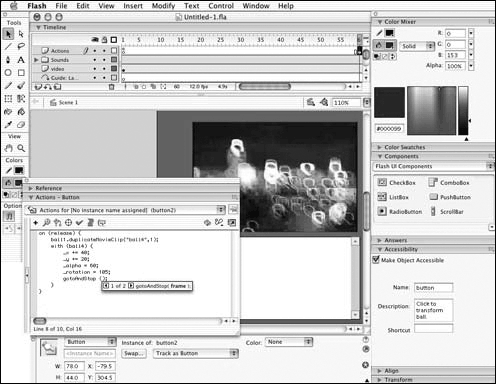| Flash is a "plug-in" technology that allows you to integrate multimedia files (animation, navigation, etc.) directly into a web page. In order for users to see your Flash file, they must have the Flash player installed, in addition to a web browser. Flash is a creation of Macromedia, and it's attracted an almost cult-like following in the web design community, because...well, largely because it's so much fun. Flash allows you to create effects that you couldn't accomplish not even close with HTML and could only otherwise produce with great technical effort and mixed results. Technically, Flash seems too good to be true. The animations are quite beautiful, with smooth transitions, rich colors, and perfectly synced sound. Flash "movies" (as they're usually called) can be stretched to fit different size browser windows and still retain the original look and feel. All this, and they download pretty quickly, too. No doubt: Flash has a lot going for it. But in truth, it's drastically overused on the web today. Most sites, in reality, don't need animation. So while it's perfectly suited to some sites, it's just a distraction on others. As with all technologies, you should know what Flash is good for, and only use it when it makes sense. (See to flash or not to flash, p. 144.) The benefits of flash: In-page interactivity. Flash allows you to create highly interactive experiences without reloading the entire page. This often improves the speed of transactions and minimizes the disorientation people experience when transitioning between steps. Smooth animation. Flash is by far the best tool for online animation. Large installed user base. As a proprietary plug-in technology, Flash isn't accessible to everyone online. But the number of users is vast and growing, because the Flash player is now bundled with each Internet Explorer browser. Fast downloads. Thanks largely to its use of vector-based graphics, Flash files compress remarkably well and download more quickly than you might expect. Also, Flash files can begin playing before the entire file is loaded (increasing their perceived speed). Scalable size. Thanks again to vector-based graphics, Flash files can stretch to fill the space available in a browser window. This makes it easier to design effectively for different-sized monitors.
what you need to know about flash what it is Flash is a so-called "plug-in" technology from Macromedia that lets you create animations or interactive, multimedia presentations and integrate them into a web page. how it's used Flash is the most popular platform for online animation and is also commonly used to create interactive experiences within a web page. why it's loved Flash vastly increases the options available to the web developer bringing animation, interactivity, video, and sound to the web page. It's efficient and downloads relatively quickly. It works with vector-based graphics, so it's scalable: The same "movie" can appear in different size windows. Although it's a plug-in technology, it ships with most browsers and is now in use by a wide majority of web users.
why it's hated Flash is often over-used in places that don't require animation or in-page interactivity. Also: It isn't universally accepted, and some users have problems managing versions. Flash-based content isn't searchable or indexable. Flash-based navigation systems are frequently non-standard and hard to use. Vector-based graphics tend to look stylistically similar, so there's a specific "Flash" look.
|
The drawbacks of Flash: It's not universal. Although most people have some version of Flash installed, they don't all have it properly installed. Also, different versions are in use. It's not searchable. The text in a Flash-based site can't be searched by the user and can't be indexed by most search engines. It's not linkable. Individual pages within a Flash file cannot be "bookmarked" or linked to individually. It's not inter-operable. The text and images in Flash files cannot be interpreted or displayed in other environments beyond the web browser. It's often unnecessary. Flash animations are often gratuitous; they frequently appear on sites that really don't need animation. And in some cases, they duplicate what could be done nearly as well and complication-free in HTML. It's often nonstandard. Interfaces built in Flash often ignore web design conventions, forcing users to learn a new system. This can be fine if you're creating an immersive site that's entertaining or educational, but counterproductive if you're building an information resource or an online store. Visual techniques are limited. Because Flash makes use of vector-based graphics, the range of visual techniques is limited. Most Flash animations have that smooth-lined, flat-colored, "Flashy" look.
learning to use flash The hard thing about using Flash isn't the developer software itself, but the skills it takes. Great Flash designers are skilled at animation, navigation, and scripting. Not an easy combination.  The Flash developer software acts as both a graphics program and a movie editor, so it combines the tools you'd expect in both types of programs. The Flash software looks like this: All Flash files are given names ending with the .swf extension. You can include them in a web page by placing a few lines of code within the HTML. So a Flash movie named "coolflashthing.swf" would be integrated like this: <object width="300" height="300"> <param name="movie" value="coolflashthing.swf"> <embed src="/books/2/132/1/html/2/coolflashthing.swf" width="300" height="300"> </embed> </object> Learn how to use Flash Webmonkey Flash tutorials http://www.webmonkey.com/authoring/stylesheets/ A List Apart Flash tutorials http://www.alistapart.com/stories/indexFlash.html
Buy this book!  | Flash to the Core: An Interactive Sketchbook Joshua Davis (New Riders, $45.00) |
|
